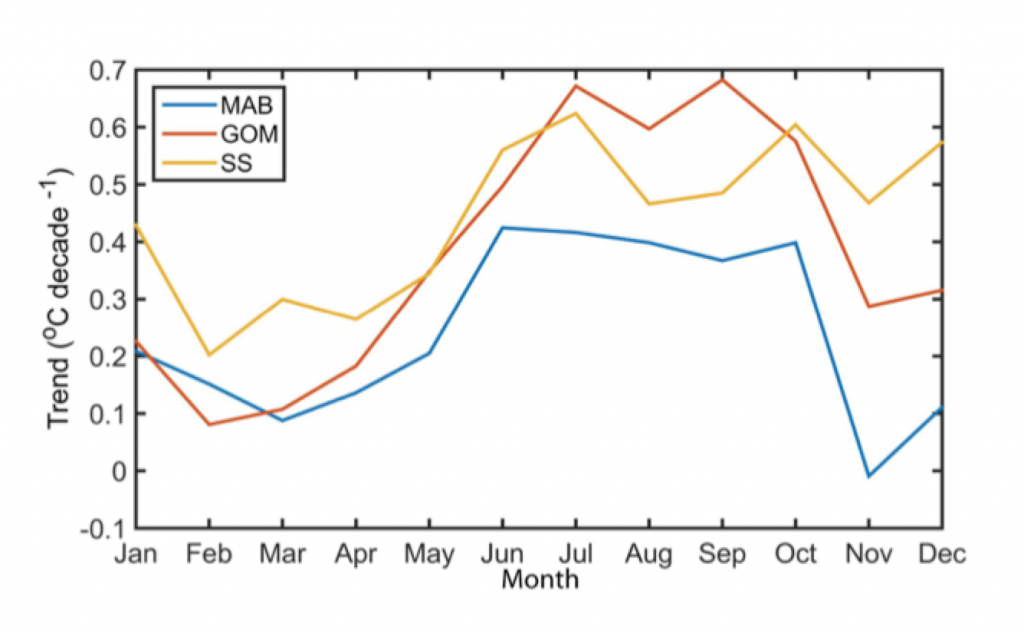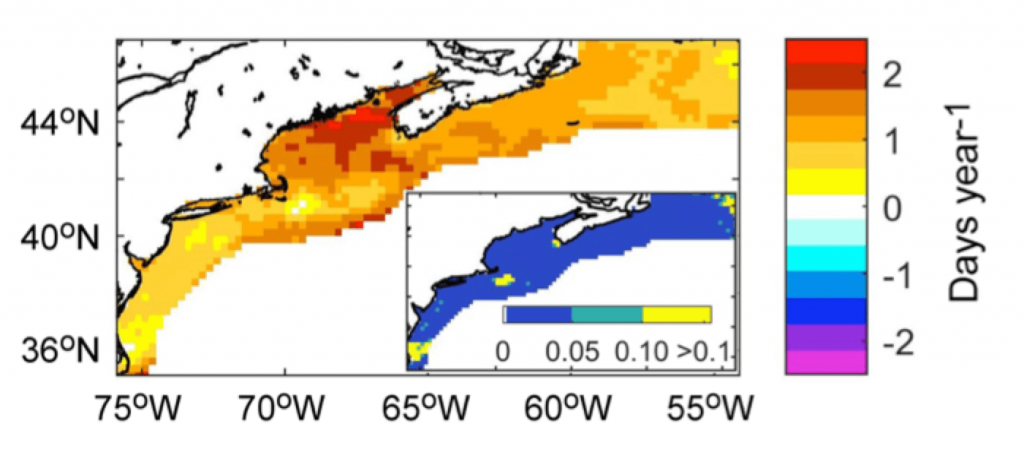
Longer, stronger summers in the Gulf of Maine
Summer is coming to the Gulf of Maine, longer and warmer than ever — as much as two months longer. That’s the message of a new research article by a team of scientists led by Andrew Thomas of the University of Maine School of Marine Sciences. The study, published in the journal Elementa, examined the seasonality of sea surface temperature trends along the northeast coast of the United States.
For all but a small region immediately north of Cape Hatteras at the southern edge of their study area, the researchers confirmed that surface water temperatures have an increasing trend over the last three decades, with the Gulf of Maine warming at about 0.4 degrees Celsius per decade. The new analysis both mapped the geographic pattern of these trends and showed that the increase is actually much stronger than this in the summer and early fall months, from June to October, and weaker in the winter months.
The research builds on previous work by Thomas and his colleagues, including Andrew Pershing and Katherine Mills of Gulf of Maine Research Institute, and others from Bigelow Laboratory, Stony Brook University and NOAA. In a widely cited 2015 paper in Science, these authors analyzed sea surface temperature data showing that the Gulf of Maine region exceeded the global average of rate of warming over the last 30 years and noted that over the past decade the Gulf of Maine warmed faster than 99.9 percent of the global ocean. Looking at details behind these trends was a logical next step. They were motivated by several questions: Do overall warming trends occur equally throughout the year, or do they occur primarily in a particular season? Which regions are the most susceptible or resilient to changes in sea surface temperature?
With funding from the National Science Foundation and NASA, they took a higher resolution version of the same set of data — 33 years of satellite measurements — and zoomed in on the northeastern North American continental shelf region. Then they separated the data into months, so they could quantify and map seasonal trends. Their results showed patterns in space and over the seasonal cycle that were not evident in earlier studies.

Summer, defined as the number of days above a specific temperature each year, has lengthened throughout the region. This trend was especially strong in the Gulf of Maine. While driven by both earlier springs and later falls, in the Gulf of Maine, steadily delaying fall timing was the main factor.
“The change rate is an increase of two summer days per year, so over the 33-year time series,” said Thomas, “it has added up to 66 days. Summer conditions in the Gulf of Maine now last about two months longer than in 1982. That’s frightening.”
Frightening, because temperature acts as a cue for the behavior and distribution of many marine species important to Maine culture and economy. How has the lengthening summer affected lobster, cod or herring?
“I’m an oceanographer, not a fish biologist,” said Thomas. “But my fisheries colleagues on the team looked at that, and in a separate paper we showed that longer summers were linked to northward shifts in the fall population centers of American lobster, Atlantic herring and Atlantic mackerel.”
Lobster and herring also increased in population sizes or total biomass, as did summer flounder, Acadian redfish and spiny dogfish. For other species, including cod, the lengthening summer warm period was associated with a decline in biomass.
The satellite records used for these studies provide temperature data for the surface of the ocean. Is it the right indicator for bottom-dwellers like cod and lobster? According to Thomas, on the relatively shallow Atlantic shelf, over multiple years, the surface trends correlate with temperatures deeper in the sea. For example, while the data records are not nearly as long, the Northeastern Regional Association of Coastal Ocean Observing Systems buoy in the middle of Jordan Basin, which measures temperatures from the surface down to a depth of 250 meters, shows less annual variability but similar long-term warming in the deep water.

“The temperature trends we see in this area are among the largest on the planet,” said Thomas. “Two main drivers are likely at play. The Gulf of Maine is at the crossroads of two major large-scale processes, both of which are impacted by climate change. Our shelf is downwind of the jet stream coming off the continent. North or south shifts in jet stream position translate into changes in atmosphere-ocean heat transfer that heat and cool the shelf water.” In his study, Thomas showed that both higher atmospheric pressure and warmer air temperatures in spring and summer were linked to the longer summer season in the sea.
The second process is the transport of ocean water. The Gulf of Maine is connected to the global ocean by currents, and much of the seawater in the Gulf originates farther north. These waters, the Labrador Sea and adjacent coastal shelves, are also among the most rapidly warming regions. To the south, the position of the Gulf Stream also has influence; Thomas showed that northerly shifts in the warm Gulf Stream were associated with longer summers in the Gulf of Maine.
A lengthening ocean summer has important biological ramifications. In summer, a shallow layer of sun-warmed but nutrient-poor water floats on top of denser, colder, nutrient-rich water. The breakdown of this structure as temperatures cool in the fall releases nutrients from the deep water that help trigger fall phytoplankton blooms that support the rest of the marine food web.
But the cooling that usually happens in fall and early winter has weakened and arrives later, extending the stratification period. “Stronger and longer summer stratification means weaker mixing and fewer and delayed nutrients coming to surface, a trend that will eventually mean the Gulf of Maine becomes less productive,” said Thomas.
Thomas also noted that with the whole northeast Atlantic shelf staying much warmer later into the fall, any hurricane arriving in this period would remain stronger than if it had occurred decades ago.
Thomas and his team are now working on applying the same seasonal analysis to the whole North Atlantic and other regions of the North American continental shelf.
Contact: Catherine Schmitt, 207.581.1434
